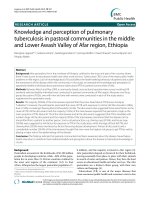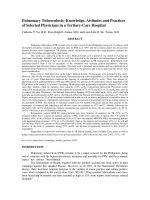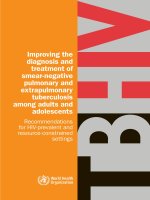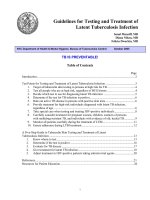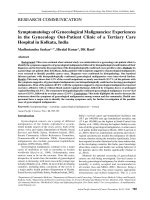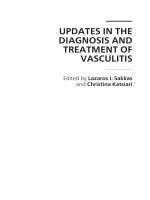Factors affecting delays in diagnosis and treatment of pulmonary tuberculosis in a tertiary care hospital in Istanbul, Turkey pptx
Bạn đang xem bản rút gọn của tài liệu. Xem và tải ngay bản đầy đủ của tài liệu tại đây (88.93 KB, 6 trang )
WWW.
MEDSCIMONIT
.COM
Clinical Research
© Med Sci Monit, 2004; 10(2): CR62-67
PMID: 14737045
CR62
Factors affecting delays in diagnosis and treatment
of pulmonary tuberculosis in a tertiary care hospital
in Istanbul, Turkey
Döndü Güneylioglubdefg, Adnan Yilmazabcdefg, Sevinc¸ Bilginbdf,
Ümmühan Bayrambf, Esen Akkayaace
Department of Pulmonology, SSK Süreyyapas¸a Center for Chest Diseases and Thoracic Surgery, Istanbul-Turkey
Source of support: none.
Summary
Background: To investigate delays in the diagnosis and treatment of inpatients with smear-positive pul-
monary tuberculosis and to identify factors affecting these delays.
Materials/Methods: 204 hospitalized patients with smear-positive pulmonary tuberculosis were identified. The
clinical files of the patients were analyzed and questionnaires were created.
Results: Mean application interval was 31.4 days, mean referral interval was 22.1 days, mean diagnosis
interval was 3.3 days, and mean initiation of treatment interval was 1.4 days. Patient delay was
present in 34.8 percent of the patients. The application interval was shorter for patients hav-
ing an index case for tuberculosis (p=0.039) and for those with good economic status
(p<0.005). 167 patients (81.9%) had institutional delay. The referral interval was longer for
female patients than for male patients (p=0.015). The most common causes of institutional
delays were a low index of suspicion for tuberculosis, health care system delays, and underuti-
lized chest X-ray examinations. One hundred and three patients (50.5%) had delays in diag-
nosis and 51 patients (25.0%) had delays in treatment. The most frequent reason for diagnos-
tic delay was health care system delays (35.9%).
Conclusions: There were several delays in the diagnosis of tuberculosis patients. For an effective tuberculo-
sis control, efforts should be made to reduce these delays. Physicians and the public should be
educated about tuberculosis. Health care system and laboratory delays should be improved.
key words: delays • smear-positive • pulmonary tuberculosis • diagnosis, treatment
Full-text PDF:
/>Word count:
2347
Tables:
5
Figures:
1
References:
26
Received: 2002.11.07
Accepted: 2003.07.03
Published: 2004.02.01
Author’s address:
Dr. Adnan Yilmaz, Maltepe Zümrütevler Atatürk Cad. Abant Apt. No:30 81530 Istanbul, Turkey,
e-mail:
Authors’ Contribution:
A
Study Design
B
Data Collection
C
Statistical Analysis
D
Data Interpretation
E
Manuscript Preparation
F
Literature Search
G
Funds Collection
CR63
Med Sci Monit, 2004; 10(2): CR62-67 Güneylioglu D et al – Delays in pulmonary tuberculosis diagnosis and treatment
CR
BACKGROUND
Prior to the twentieth century, tuberculosis was one of
the major causes of death in both developed and devel-
oping countries [1]. During the twentieth century it con-
tinued to be a major public health problem worldwide.
In 1993, the World Health Organization (WHO)
declared a state of global emergency for tuberculosis due
to the steady increase of the disease worldwide [2]. It is
estimated that by the year 2005 12 million cases of tuber-
culosis will be identified in the world annually, a 58%
increase from the 7.5 million estimated for 1990 [3]. It
was reported that 19% to 43% of the world’s population
was infected with Mycobacterium tuberculosis [4]. One of
the main objectives in any tuberculosis control program
is to reduce tuberculosis transmission in the community
through early detection of tuberculosis cases and prompt
implementation of a full course of therapy [5]. This is
especially important in the case of untreated smear-posi-
tive patients, who are the main sources of infection in a
community [5,6]. Delays in the diagnosis and start of
effective treatment of tuberculosis patients result in a
prolonged period of infectivity in the community and
health care workers [7–9]. These delays have been noted
in both high- and low-prevalence countries [6,7,10–16].
Turkey has an estimated incidence of tuberculosis of 30
per 100,000 of the population. The SSK Süreyyapa
l
ba
Center, located in Istanbul, is a tertiary care hospital for
chest diseases and tuberculosis. This center is one of
Turkey’s main health facilities and provides treatment
to tuberculosis patients who have been referred by dis-
trict health care facilities throughout the country. In
this study, we aimed to investigate delays in the diagno-
sis and treatment of hospitalized patients with smear-
positive pulmonary tuberculosis and to identify the fac-
tors affecting these delays.
MATERIAL AND METHODS
The present study was conducted at the SSK Sürey-
yapa
l
ba Center for Chest Disease and Thoracic Surgery,
consisting of 1600 beds. We reviewed the clinic records
of all patients hospitalized between June and August
2001 and identified 204 newly diagnosed inpatients
with smear-positive pulmonary tuberculosis. Cases with
previous histories of tuberculosis treatment were
excluded.
Study design
The clinical files of the cases were analyzed and a ques-
tionnaire was created to obtain data by interview. For
each patient, the following information was gathered:
(1) sex, (2) age, (3) education level, (4) area of residence,
(5) index case, (6) economic status, (7) first symptom, (8)
first visiting physician, (9) symptom duration, (10) date
of first doctor visit, (11) date of admission to hospital,
(12) date of diagnosis, and (13) date of treatment initia-
tion. The presence of cough, fever, night sweats,
hemoptysis, weight loss, anorexia, fatigue, and dyspnea
were the criteria for the onset date of symptoms.
Patients were classified as ‘urban’ if they lived in a city
or metropolis and ‘rural’ if they lived in the towns and
villages surrounding these. The patients were catego-
rized into three groups with respect to their economic
status. When monthly income was below $200 (US), the
patient’s economic status was regarded as poor.
Monthly income was between $200 and $550 for
patients with moderate economic status. Patients with
good economic status had monthly incomes over $550.
The following time intervals and delays were deter-
mined for each patient: The patient’s application interval
was defined as the time interval between the onset of
symptoms and the first doctor visit. Intervals that
exceeded 30 days were considered indicative of a patient
delay [12]. The referral interval was defined as the time
from the first doctor visit to admission [17]. With regard
to our health care system, intervals that exceeded two
days were considered indicative of an institutional delay
[14]. The diagnosis interval was regarded as the time from
admission to a positive acid-fast smear. Intervals that
exceeded one day were considered indicative of a
delayed diagnosis [14,18]. The treatment interval was the
time from diagnosis to initiation of treatment. Intervals
that exceeded one day were considered indicative of a
delayed treatment [14,18]. Clinic delay was defined as the
time from admission to initiation of treatment. Regar-
ding the diagnosis and treatment intervals, those that
exceeded two days were considered indicative of a
delay. Doctor delay was defined as the time from the first
doctor visit to initiation of treatment. Intervals that
exceeded four days were considered indicative of a
delay [14,19]. Figure 1 presents the time intervals and
delays. The reasons for the delays were also evaluated.
Statistical analysis
The chi-square test, ANOVA test or Student-t test were
used to assess differences between groups.
RESULTS
During the study period, 204 new smear-positive adult
patients were evaluated. There were 122 male and 82
female. The mean age of the patients was 38.6 years
(range 14–90 years). One hundred and eighteen
patients (57.9%) had primary school education, 56
(27.4%) had secondary school education, 7 (3.4%) were
university graduates and 23 (11.3%) had no formal edu-
cation. One hundred and fifty-one patients (74%) lived
in urban areas and 53 patients (26%) in rural areas.
While 139 patients (68.1%) had no history of an index
case for tuberculosis, there was a positive history in 65
cases (31.9%).
Table 1 presents the values of the intervals. The mean
values of the time intervals (SD) were 31.4 (38.9) days
for the application interval, 22.1 (29.7) days for the
referral interval, 3.3 (5.2) days for the diagnosis interval,
and 1.4 (1.8) days for the initiation of treatment inter-
val. The application interval was shorter than 30 days in
133 patients (65.2%) and longer than 30 days in 71
patients (34.8%). According to these results, 34.8% of
the patients had patient delays.
CR64
Med Sci Monit, 2004; 10(2): CR62-67Clinical Research
Table 2 gives a sub-analysis of application interval and
patient delays with respect to several factors. Age, sex,
area of residence, and education level had no effect on
the application interval. Significantly shorter mean appli-
cation intervals were noted in patients having an index
case for tuberculosis (p=0.04) and patients who had good
economic status (p=0.03). The rate of cases having
patient delay was lower among patients with hemoptysis
than patients with other first symptoms (p=0.04).
Factors associated with the referral interval are summa-
rized in Table 3. The referral interval was shorter than
three days in 37 patients (18.1%). This interval was
between 3 and 10 days in 64 patients (31.4%) and was
longer than 10 days in 103 patients (50.5%). One hun-
dred and sixty-seven (81.9%) patients had institutional
delay. Sub-analysis identified 200 reasons for institu-
tional delay in these patients. While age, education
level, residence area, and economic status had no effect
on the referral interval, this interval was significantly
shorter in male patients (p=0.015). Similarly, the rate of
cases having institutional delay was significantly lower
among male patients (p=0.003). Patients referred by a
chest specialist had a significantly shorter referral inter-
val than those referred by the other physicians
(p=0.043), with a subsequent lower rate of institutional
delay (p=0.038). Of the 167 patients with an institution-
al delay, tuberculosis was not suspected in 82 patients
(41%) at the time of their first visit. Fifty-one patients
(25.5%) had delays in chest-X ray examinations. There
were delays in the health care system in 47 (23.5%)
patients. Economic status resulted in institutional delays
in twelve patients (6%). The reason of institutional delay
was not identified in eight patients (4%).
Table 4 shows the distribution of the diagnosis intervals
and initiation of treatment intervals with respect to
days. One hundred and three patients (50.5%) had
delays in diagnosis and 51 patients (25%) had delays in
initiation of treatment. The mean (95%, CI) diagnosis
interval was 3.7 days (2.5 to 4.0 days) in male patients
and 2.4 days (1.9 to 2.9 days) in female patients
(p=0.015). Age and education level had no effect on the
diagnosis interval. Our health care system resulted in
delayed diagnosis in 37 patients (35.9%). Reasons for
delayed diagnosis included underutilized or delayed
sputum examinations for acid-fast smears in 30 patients
(29.1%). A low index of suspicion for tuberculosis by a
chest physician was a reason of delayed diagnosis in 22
patients (21.4%). While laboratory delays were identi-
fied in 9 patients (8.7%), no reason was determined for
delayed diagnosis in 5 patients (4.9%). The mean initia-
tion of treatment interval (95%, CI) was 1.5 days (1.2 to
1.8 days) in male patients and 1.3 days (0.9 to 1.7 days)
in female patients (p>0.05). Age and education level
had no effect on this interval.
The distribution of time from the first doctor visit to ini-
tiation of treatment with respect to days is shown in
Table 5. The mean (95%, CI) interval was 26.7 days
(22.5 to 30.8 days) and median interval was 15 days.
There were doctor delays in 178 of 204 patients
(87.2%). The mean interval (95%, CI) from onset of
symptoms to initiation of treatment was 64.1 days (55.2
to 73.1 days). This interval suggested total delay.
DISCUSSION
We analyzed delays in the diagnosis and treatment of
inpatients with smear-positive pulmonary tuberculosis
and factors affecting these delays. The present study
indicated that there were several delays between the
onset of symptoms and initiation of treatment in our
patients. These delays included patient delay, institu-
tional delay, diagnostic delay, and delay in the treat-
ment. Both patient and institutional delays result in
increased infection risk for the population. Diagnostic
and treatment delays result in increased infection risk
for medical personnel [14]. An untreated smear-positive
patient may infect on average more than 10 contacts
onset of first visit to admission to diagnosis initiation of
symptoms physician hospital treatment
patient’s delay institutional diagnostic delay delayed treatment
delay
application interval referral interval diagnosis interval treatment interval
doctor’s delay
Clinic delay
Figure 1. Components of the
time from onset of
symptoms to initiation
of treatment and the
delays.
Interval Mean SD Median 95% CI
Application
Referral
Diagnosis
Treatment
31.4
22.1
3.3
1.4
38.9
29.7
5.2
1.8
17.5
11.0
1.5
1.0
26.1–36.7
18.1–26.2
2.5–4.0
1.2–1.7
Table 1. The values associated with several intervals (days).
CR65
Med Sci Monit, 2004; 10(2): CR62-67 Güneylioglu D et al – Delays in pulmonary tuberculosis diagnosis and treatment
annually [20]. A previous report indicated that at least
24% of the employees exposed to infectious tuberculosis
in their office for 4 months were infected [13]. Delays
for patients with pulmonary tuberculosis are more com-
mon in developing countries [10,12,14]. A has previous
report suggested that delays associated with pulmonary
tuberculosis were common in Turkey [14]. Delays have
also been reported in developed countries [7,11,13].
In our study, the median application interval was found
to be 17.5 days. Seventy-one patients (34.8%) had
patient delay. While many reports present a shorter
median application interval than ours [21,22], longer
median application intervals were noted in two previous
studies [10,12]. This interval was between 0.3 weeks and
120 days in these reports [12,22]. A previous report
indicated that 28.4 percent of the patients had patient
delay and that the median application interval was 17.5
days [14]. The rate of patient delay was slightly higher
in the present study than in our previous report.
Similar median application intervals were determined
in these series.
This study showed that the rates of doctor delay were
higher than those of patient delay. We noted that one
hundred and seventy-eight patients (87.2%) had doctor
delay and that the median doctor delay was 15 days. A
previous report indicated that the rate of doctor delay
was 88.2% and that the median doctor delay was 9 days
[14]. Liam et al. reported that median doctor delay was
7 weeks [21]. Doctor delay included institutional delay,
diagnostic delay and delayed treatment [14]. The rates
of delay were 81.9% for institutional delay, 50.5% for
diagnostic delay, and 25% for delayed treatment in the
present study. These results indicate that the rate of
institutional delay was more significant than those of
delays in diagnosis and treatment. In a previous study,
the rates of institutional, diagnostic and treatment
delays were presented as 61.1%, 69.4% and 25.4%,
respectively [14]. Pirkis et al. reported lower rates of
delayed treatment than our study. [11] The median
interval for diagnosis was 6.5 days in a previous report
[7]. Taylor et al. [17] noted that the median referral
interval was 18 days. When our results were compared
with these reports, it was suggested that our patients
had shorter median referral and diagnosis intervals, but
longer treatment intervals.
It is known that the length of the interval may be associ-
ated with several factors [12,16,21,23–25]. Long et al.
reported that the application interval was longer among
women than among men [22]. A previous report noted
longer patient delay in patients aged 45 years and over
and in rural patients [12]. However, Liam et al. showed
that sex [21], age, education level, and initial symptom
had no significant association with patient delay. We
ascertained lower application intervals for patients hav-
ing an index case for tuberculosis and for those with
good economic status. The rate of cases having patient
delay was lower among patients with hemoptysis than
patients with cough and other symptoms. We also found
that sex, age, residence area, and education level had no
significant effect on the application interval. The referral
interval was shorter in males than in females. This inter-
CR
Application interval (days) Patient delay n (%)
Mean (SD) Median 95% CI Yes No p
Sex
Male
Female
Age
<45
≥45
Residence
Urban
Rural
Index case
Yes
No
Education
No education
Primary
Secondary
University
Economic status
Poor
Moderate
Good
First symptom
Cough
Hemoptysis
Other
35.2 (42.9)*
25.7 (31.4)*
29.5 (38.3)*
34.5 (39.8)*
33.2 (43.2)*
25.8 (22.2)*
25.0 (37.5)**
33.6 (39.1)**
34.1 (44.8)***
33.8 (39.5)***
27.4 (31.3)***
19.3 (18.1)***
66.2 (52.5)
21.9 (24.9)
9.8 (9.1)
32.1 (38.0)
26.6 (43.1)
33.1 (36.6)
45 (36.9)**
26 (31.7)**
41 (32.5)**
30 (38.5)**
51 (33.8)**
20 (37.7)**
16 (24.6)
55 (39.5)
7 (30.4)*
47 (39.8)*
15 (26.8)*
2 (28.6)*
44 (83.0)
#,##
25 (21.7)
#,
*
2 (5.6)
##,
*
49 (37.1)
###,&
8 (20.0)
###,&&
14 (43.8)
&,&&
77 (63.1)
56 (68.3)
85 (67.5)
48 (61.5)
100 (66.2)
33 (62.3)
49 (75.4)
84 (60.5)
16 (69.6)
71 (60.2)
41 (73.2)
5 (71.4)
9 (17.0)
90 (68.3)
34 (94.4)
83 (62.9)
32 (80.0)
18 (56.2)
18.0
15.0
17.0
19.0
16.0
20.0
13.0
20.0
15.0
16.0
16.0
15.0
52.0
15.0
8.0
20.0
10.0
20.0
27.4–42.6
18.7–32.5
22.8–36.2
25.5–43.4
26.4–40.2
19.6–31.9
15.7–34.3
27.1–40.1
14.7–53.4
8.4–48.9
19.0–35.8
2.5–36.1
51.7–80.7
17.3–26.5
6.7–12.9
25.6–38.6
12.8–40.4
19.8–46.2
*
,
**p>0.05
*
,
**p>0.05
*
,
**p>0.05
**p=0.039
*
,
*** p>0.05
#
p<0.005
##
p<0.005
*p=0.026
###
p=0.055
&
p>0.05
&&
p=0.04
Table 2. A sub-analysis of patient delay.
CR66
Med Sci Monit, 2004; 10(2): CR62-67Clinical Research
val was also shorter in patients who visited a chest spe-
cialist. Age, education level, residence area, and econom-
ic status had no significant effect on the referral interval.
While Nakagawa et al. found that the referral interval
was longer in female than in male patients [24], Taylor
et al. determined that the median referral interval was
similar between males and females [17]. It is known that
health care providers and physicians first visited by
patients affect the rates of doctor delay [12,21,25]. In our
opinion, the degree of suspicion of tuberculosis differs
among physicians, and this difference may be an impor-
tant reason for difference among doctor delays. There
are several differences among the studies with respect to
delays. We conclude that the patient’s characteristics
may result in these differences among studies.
Many reasons for delays have been identified in previ-
ous reports. Underutilized chest X-ray examinations
and sputum smear examinations, a low degree of suspi-
cion of tuberculosis, health care system and laboratory
delays, as well as patient characteristics, such as age, sex,
education level and socioeconomic status, are the most
common reasons for doctor delays [7,12,14,16,18,26].
We determined similar reasons for delays. A low degree
of suspicion of tuberculosis was one of the most com-
mon causes for delay among our patients. Chest X-ray
and sputum smear examinations were underutilized by
physicians in our patients with pulmonary tuberculosis.
The present data suggest that the health care system
and laboratory delays result in high rates of institutional
and diagnostic delays. Poor economic status was an
important reason of patient delay in our series.
CONCLUSIONS
In conclusion, the present study suggests that our
patients with smear-positive pulmonary tuberculosis had
several delays from the onset of symptoms to initiation of
treatment. Because untreated smear-positive patients are
the main sources of infection, delays in the diagnosis and
treatment of these patients increase the risk of disease
transmission in the community. These delays are also
associated with a prolonged period of infectivity for
medical personnel. According to our data, doctor delay
was more significant than patient delay, and institutional
delay was the most important component of doctor
delay. The low index of tuberculosis, underutilized chest
Days
n%n%
Diagnosis interval Diagnosis interval
0–1
2–10
>10
101
93
10
153
50
1
49.5
45.6
4.9
75.0
24.5
0.5
Table 4. The distribution of diagnosis and treatment intervals with
respect to days.
Days n %
0–4
5–10
11–20
>20
26
53
36
89
12.8
26.0
17.6
43.6
Table 5. The distribution of the time interval between the time
of the first doctor visit and initiation of treatment with
respect to days.
Referral interval (days) Institutional delay n (%)
Mean (SD) Median 95% CI Yes No p
Sex
Male
Female
Age
<45
≥45
Residence
Urban
Rural
Education
No education
Primary
Secondary
University
Economic status
Poor
Moderate
Good
First visit
Chest specialist
Practitioner
Other
19.1 (28.7)*
26.6 (30.8)*
20.5 (26.9)*
24.8 (33.1)*
21.2 (27.8)*
22.6 (30.5)*
29.6 (37.2)**
21.3 (30.5)**
19.8 (21.9**
14.1 (21.3)**
25.1 (34.6)*
21.5 (27.8)*
20.3 (28.3)*
11.4 (20.6)**
23.1 (26.8)**
25.3 (33.0)**
91 (74.6)***
76 (92.7)***
104 (82.5)***
63 (80.8)***
123 (81.5)***
44 (83.0)***
21 (91.3)*
95 (80.5)*
45 (80.4)*
6 (85.7)*
41 (77.4)***
95 (82.6)***
31 (86.1)***
26 (68.4)*
47 (83.9)*
94 (85.5)*
31 (25.4)
6 (7.3)
22 (17.5)
15 (19.2)
28 (18.5)
9 (17.0)
2 (8.7)
23 (19.5)
11 (19.6)
1 (14.3)
12 (22.6)
20 (17.4)
5 (13.9)
12 (31.6)
9 (16.1)
1 6 (14.5)
7.5
14.5
11.0
11.0
11.0
11.0
19.0
8.0
11.0
4.0
15.0
10.0
11.0
6.0
14.0
14.0
14.0–24.2
19.8–33.4
15.8–25.1
17.4–32.3
13.4–29.0
17.7–27.1
13.5–45.7
15.5–27.1
13.9–25.6
5.5–33.8
15.5–34.6
16.3–26.6
10.7–29.9
4.7–18.2
15.9–30.3
19.1–31.6
*p=0.015
***p=0.003
*
,
***p>0.05
*
,
***p>0.05
*
,
**p>0.05
*
,
***p>0.05
**p=0.043
*p=0.48
Table 3. Factors associated with the referral interval.
CR67
Med Sci Monit, 2004; 10(2): CR62-67 Güneylioglu D et al – Delays in pulmonary tuberculosis diagnosis and treatment
X-ray and sputum smear examinations among physi-
cians, and health care system and laboratory delays were
the most common causes of doctor delay. Several efforts
should be made to reduce these delays for the sake of
tuberculosis control. Physicians and the public should be
educated about tuberculosis. Health care system and lab-
oratory delays should be minimized. These efforts can
reduce delays in pulmonary tuberculosis treatment. We
conclude that delays are important reasons for the
increased period of infectivity, and that decreasing these
delays will help tuberculosis control.
REFERENCES:
1. Bloom BR: Tuberculosis: back to a frightening future. Nature,
1992; 358: 538-39
2. World Health Organization: TB a global emergency.
WHO/TB/94.177. Geneva: World Health Organization, 1994
3. Centers for Disease Control and Prevention. Estimates for future
global tuberculosis morbidity and mortality. MMWR Morb Mortal
Wkly Rep, 1993; 42: 961-64
4. Sudre P, Dam GT, Kochi A: Tuberculosis: a global overview of the
situation today. Bull World Health Org, 1992; 70: 149-59
5. Enarson DA, Rieder HL, Arnadottir T, Trebucq A: Tuberculosis
guide for low income countries. 4
th
ed., Paris, France: International
Union Against Tuberculosis and Lung Disease, 1996
6. Salaniponi FML, Harries AD, Banda HT et al: Case seeking behav-
iour and diagnostic processes in patients with smear-positive pul-
monary tuberculosis in Malawi. Int J Tuberc Lung Dis, 2000; 4:
327-32
7. Mathur P, Sacks L, Auten G et al: Delayed diagnosis of pulmonary
tuberculosis in city hospitals. Arch Intern Med 1994; 154: 306-10
8. Iseman MD: A leap of faith: what can we do to curtail intra institu-
tional transmission of tuberculosis? Ann of Int Med, 1992; 117:
251-53
9. Menzies D, Fanning A, Yuan L, Fitzgerald M: Tuberculosis among
health care workers. N Engl J Med, 1995; 333: 92-98
10. Lawn SD, Afful B, Acheampong JW: Pulmonary tuberculosis: diag-
nostic delay in Ghanaian adults. Int J Tuberc Lung Dis, 1998; 2:
635-40
11. Pirkis JE, Speed BR, Yung AP et al: Time to initiation of anti-tuber-
culosis treatment. Tuberc Lung Dis, 1996; 77: 401-06
12. Wandwalo ER, Morkve O: Delay in tuberculosis case-finding and
treatment in Mwanza, Tanzania. Int J Tuberc Lung Dis 2000; 4:
133-38
13. MacIntyre CR, Plant AJ, Hulls J et al: High rate of transmission
of tuberculosis in an office: impact of delayed tuberculosis. Clin
Infect Dis 1995; 21: 1170-74
14. Yilmaz A, Boga S, Sulu E et al: Delays in diagnosis and treatment
of hospitalized patients with smear-positive pulmonary tuberculo-
sis. Respir Med, 2001; 95: 802-05
15. Counsell SR, Tan JS, Dittus RS: Unsuspected pulmonary tubercu-
losis in a community teaching hospital. Arch Intern Med, 1989;
149: 1274-78
16. Sherman LF, Fujiwara PI, Cook SV et al: Patient and health care
system delays in the diagnosis and treatment of tuberculosis. Int J
Tuberc Lung Dis, 1999; 3: 1088-95
17. Taylor WR, Zumla A: Referral times of Vietnamese refugees with
tuberculosis in camps in Hong Kong. Int J Tuberc Lung Dis, 2000;
4: 350-55
18. Rao VK, Iademarco EP, Fraser VJ, Kollef MH: Delays in the suspi-
cion and treatment of tuberculosis among hospitalized patients.
Ann Intern Med, 1999; 130: 404-11
19. Calder L, Gao W, Simmons G: Tuberculosis: reasons for diagnostic
delay in Auckland. N Z Med J, 2000; 113: 483-85
20. Styblo K: Epidemiology of tuberculosis; selected papers. The Royal
Netherlands Tuberculosis Association, 1991; 24: 53-54
21. Liam CK, Tang BG: Delay in the diagnosis and treatment of pul-
monary tuberculosis in patients attending a university teaching hos-
pital. Int J Tuberc Lung Dis, 1997; 1: 326-32
22. Lienhardt C, Rowley J, Manneh K et al: Factors affecting time
delay to treatment in a tuberculosis control programme in a sub-
Saharan African country: the experience of the Gambia. Int J
Tuberc Lung Dis, 2001; 5: 233-39
23. Long NH, Johansson E, Lonnroth K et al: Longer delays in tuber-
culosis diagnosis among women in Vietnam. Int J Tuberc Lung
Dis, 1999; 3: 388-93
24. Yamasaki-Nakagawa M, Ozasa K, Yamada N et al: Gender differe-
nce in delays to diagnosis and health care seeking behaviour in
a rural area of Nepal. Int J Tuberc Lung Dis, 2001; 5: 24-31
25. Enkhbat S, Toyota M, Yasuda N, Ohara H: Differing influence on
delays in the case-finding process for tuberculosis between general
physicians and specialists in Mongolia. J Epidemiol, 1997; 7: 93-98
26. Steen TW, Mazond GN: Pulmonary tuberculosis in Kweneng
District, Bostwana: delays in diagnosis in 212 smear positive
patients. Int J Tuberc Lung Dis, 1998; 2: 627-34
CR
